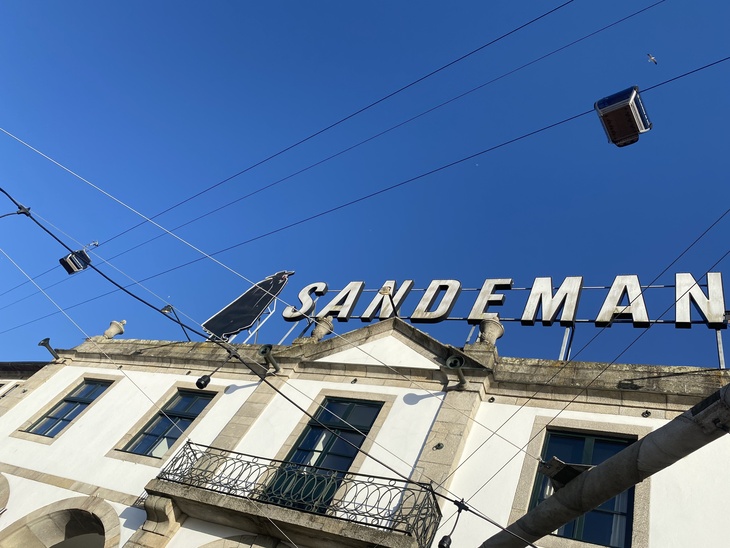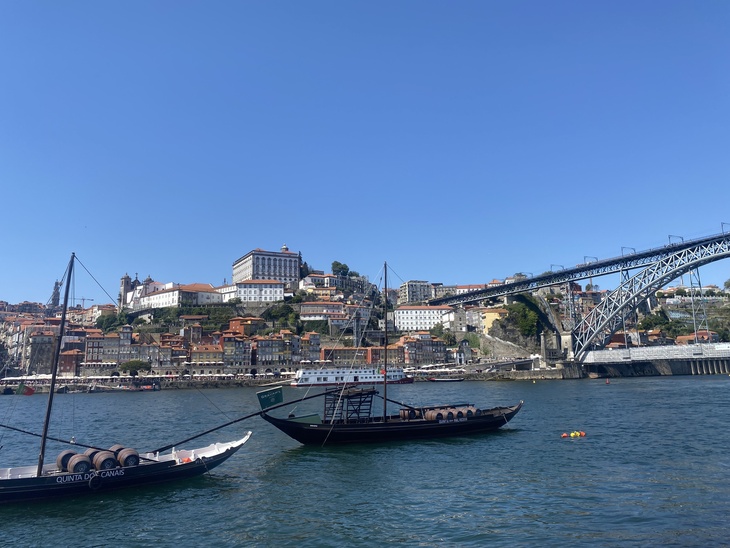
Plenty of people seem to be jetting off Porto right now, and who can blame them. This dazzling UNESCO city on the sloping banks of the Douro River is touristy but not deafeningly so; romantic but not to the point of sickliness. The locals are lovely, too. And then there's those custard tarts... Looking for things to do in Porto? Here's how to do Portugal's second city in 48 hours, in style.
Getting to Porto

A number of airlines go direct from London to Porto, from a number of London airports. You'll fly into Francisco Sá Carneiro Airport (hopefully) and from here it's roughly 15 mins in a taxi or 30-40 mins on the train into the city centre. Easy peasy.
Porto need to know

- Getting around Porto: Though it's the second-largest city in the country, Porto is relatively well-contained (certainly the bits you'll most want to see on a first trip). You may well end up walking most of the time, although there is a nifty metro/light rail service should you need it.
- Accommodation: The city's Airbnb game is strong; you should be able to find a very decent, central apartment (in, say, Baixa or Bolhão) for a reasonable price, especially if you're travelling with others. Splashing out options include the musical Mouco Hotel, where you can spin records and play on instruments; and The Yeatman, with its outdoor pool with views to die for.
- Port and pastries: Porto gives its name to the fortified wine we glug way too much of once every December. But believe us, by the end of your trip, you'll be a staunch believer that port is for life, not just Christmas. The city's other great vice are the pasteis de nata, which translates roughly as: 'seriously, give these posh custard tarts a knighthood or something'. You will come back from Porto a tad heavier and a lot happier.
- Top tiles: Those blue and white ceramic tiles veneering Porto's churches, train stations and your mate's Instagram feed are 'azulejo' tiles, and have adorned the city since the 14th century. They are quintessentially Porto, you'll see them everywhere, and wind up with 700 photos of them on your phone.
Day one
Sightseeing in Porto

Porto's not like Paris or Rome, in that you won't be madly dashing about ticking things off. It's more the sort of place you meander, sip a Super Bock, leave things to happenstance. (He says, writing a guide to Porto.)
The best way to admire the architecture? Get lost among the streets, although there are some blockbuster attractions to consider: the glimmering Bolsa Palace (which you can explore via guided tour); the Monument Church Of St Francis (so plastered in bling it makes 50 Cent look normcore) and the Livraria Lello, basically Daunt Books' hot Portuguese cousin, and due to its rumoured (and, apparently, false) Harry Potter connections, cursed with a queue that's longer than both parts of Deathly Hallows combined.

A-list views of Porto can be had from the Clérigos Tower (Porto's answer to The Monument), although there's usually a queue and always a fee. Chances are, you'll have spotted the Dom Luís I Bridge from the plane; this Tyne-Bridge-on-steroids has two pedestrian levels (one of which carries trams), and the views from the top tier are knockout. You'll be using it to get over to the port lodges — more of which later.
Down by the waterfront on the north side of the Douro is the Cais da Ribeira, with its countless bars and eateries, and live sets from musicians, it has real 'I'm on holiday' vibes — plus you can go off exploring the winding cobbled alleyways in the hinterlands.
Where to see Porto's azulejo tiles

Porto's azulejo tiles are a whole form of tourism in their own right. They're a triple threat too: stunning works of art, storytelling devices, and a way of keeping buildings cool. You'll see the beautiful blighters all over the place, although we recommend you make a point of seeing these three:
- Capela das Almas: this church is slathered in azulejo, telling the stories of saints. It's free to go inside, but it's all about the exterior.
- Porto Cathedral: top-notch cloister game here, with the bright whites and blues of the azulejo a stark contrast to the medieval gothic vibes elsewhere.
- São Bento train station: all four walls of the entrance hall of Porto's main train station are chocca with 22,000 of Jorge Colaço's tiles, which make up friezes depicting Portugal's rural/warmongering past.

While you're at Sao Bento, call in at the McDonald's round the corner — not for nuggets, but to swoon over its location inside the former Imperial Cafe; the art deco stained glass above the counter is the cat's pyjamas.
The port cellars of Porto

Porto has been making port ever since the mid 17th century, when the British and French has a barney, and the former decided to start exporting wine from Portugal en masse. The Brits didn't really go for the wine, but when fortified with brandy, suddenly loved it, and the port industry went into overdrive. Though the grapes are grown further east in the Douro Valley, the port itself is aged in barrels in Vila Nova de Gaia on the south banks of Porto (technically a separate city, in the same way Buda and Pest are).

The riverside and hillsides of Vila Nova de Gaia are studded with labels you usually see when unwrapping Christmas pressies from your aunt: Taylor's, Sandeman, Graham's, Dow's, Cockburn's. You'll struggle to put a foot wrong when it comes to visiting port lodges, but: the audio tour at Taylor's is a thorough introduction to port, and ends in a paradisiacal garden for a tasting sesh among rose bushes and peacocks; Sandeman has a waterfront terrace with prized golden hour vistas; and Calém puts on fun port and fado evenings. If you love port, you will get to know these lodges, and many more.
The best francesinha in Porto?

All that port-quaffing has made us hungry; time for some traditional Porto fare. We're so obsessed with its artery-narrowing invention, the francesinha, we once chased the dish across London. Plenty of places will tell you they do the best — one of them being Café Santiago in Bolhão (and we can tell you, it's pretty darned good). For our money (and that of a local barman), Brasão Aliados is where it's at; the sauce is extra thick/cheese-riddled/oily in the best possible way. They also make their own own IPA here, meaning the 20-or-so-minute wait to be seated is a trifling matter when considering the orgy of cheese/meat/bread/beer sauce that awaits inside.
Other Porto restaurants/foodstuffs are available, with Baixa and Bolhão brimming with both old school, and more Hackney-esque, offerings. But yeah, sorry, we mainly ate francesinha on our trip. That and pastries...
Day two
Eating pastries in Porto

About those pastries. Throw caution (and cornflakes) to the wind, and do breakfast Porto style. This place is all about the pastries, in particular the ubiquitous pastéis de nata — unctuously crispy/chewy/flaky tarts oozing with slightly burnt custard, which you'll probably start seeing in your dreams. You will scoff plenty of these things from plenty of places within 48 hours. But a brace of custard joints we personally recommend: Nata Lisboa and the very well-turned-out Fábrica da Nata. Both offer very reasonable breakfast deals incorporating pastéis de nata, and both are in the central Bolhão neighbourhood. They're also close to Mercado Temporário do Bolhão; descend the escalators into this indoor market and find a gem of a juice stall, selling freshly-squeezed orange, mango, watermelon and the like for a piffling two euros. There you go, now you've had some non-custard vitamins.
Cable cars, boat trips and the funicular

Well, the Funicular dos Guindais was closed when we were in Porto, but when working, the cute Victorian railway system is a nifty way of climbing back up from the Ribeira back into town — and doesn't cost much to ride. On the other side of the water, there's a cable car — a slightly flashier way to save your legs/drink in the views. If you're a sucker for bridges, take one of the boat tours from the harbour (approx. 15 euros), and they'll show you six of 'em (though the auto voice over is a bit naff). There's also a sprinkling of heritage trams (and a tram museum!), although none here quite match the famous number 28 in Lisbon.
Beaches and seafood in Porto

You don't really come to Porto for its beaches, but it does have 'em, especially if you're up for a bit of a hike. One jaunt we can recommend is a 90-minute saunter westward along the waterfront on the Vila Nova de Gaia side. You'll pass under the Ponte da Arrábida (which you can climb, btw) and will eventually hit the sandy shores of Praia de Lavadores. (You could also get a taxi or hop on a rented cycle.)
Once you're done swimming/sunbathing, call in at Afurada for a fish lunch. Many restaurants here close mid-afternoon till evening, but Pedra Furada Tasca remains open (though closed Mondays), serving up freshly barbecued sardines, octopus salad and the like — accompanied by lashings of the local 'vinho verde'. Then catch up on the area's fishing heritage at the free Centro Interpretativo do Património da Afuradae museum/gallery.
On the list for next time...

If you're in Porto longer than two days, make sure you get out into the Douro Valley. Its slopes vibrant with manicured vine terraces (at the right time of year anyhow) and studded with 'quintas' (wineries), this is where the country's wine/port making magic begins. It's a gorgeous spot to unwind with a glass or two, but even if you're on the wagon, it's such a pretty place to hang. Various organised tours are bookable, but in our opinion the smartest thing is to catch a train from São Bento (much of the two-and-a-half journey rolls along riverside), and call in at a couple of quintas for a snifter (though book ahead for tours, posh picnic baskets and the like). We adore the Douro.




